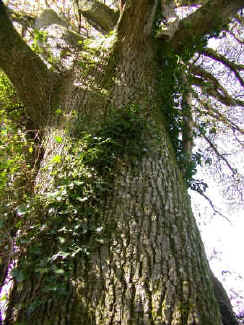
Woodlands &
Biodiversity (4)
Wood & Tree Age

As trees age, they get bigger. With increased size comes increased surface area for other plants to colonize, more gnarled and fissured bark, rot-holes and caverns in the trunk, together with the production of flowers, fruits and seeds. Past a certain size, the tree will begin to senesce and bits of it will die off, remaining attached to provide standing rotting wood microhabitats. Old trees therefore develop a wealth of microhabitats for other organisms and a large surface area for colonization. By extension, the more old trees a particular woodland contains, the greater its biodiversity is likely to be.
| In general, biodiversity within woodlands increases
both with the age of the individual trees which it contains and the historical age of the
wood. It seems too obvious to even comment upon, but as trees age, they get bigger! A small sapling, only a few metres tall, with relatively smooth bark and few branches, will gradually acquire, along with added height, a complicated branching pattern and myriads of individual branches and twigs. Each year that the tree grows, a new ring of wood (xylem) is laid down within the trunk and each of the branches. This provides the conduit which will carry water to all parts of the tree. As a result, with each successive new layer of wood, the tree's girth increases. The outer layer of bark must therefore also expand to accommodate the new girth and new layers of bark will be laid down. Bark acts in a similar way to our skin, protecting against attack by fungi, bacteria, insects and other animals. It is also water-proof and protects underlying layers from drying out. The type of bark varies depending on the species of tree. Some trees have a very thin bark, which remains relatively smooth, while others have a very thick bark. In some trees, the older bark readily peels away or breaks off. In this case the bark tends to be very papery. In species where the older layers of bark remain attached, a very thick layer can build up on the outside of the tree which is only gradually worn away. As the old dead layers on the outside are subjected to increasing pressure from the expanding inner girth of the tree, the bark will become progressively more gnarled and fissured.
The increase in the number of branches and twigs as the tree grows, allows for the space to produce a much greater number of leaves. The more leaves the tree has functioning, the more food it can produce for itself through the process of photosynthesis. However, there is a trade-off here. The more branches the tree has, the more wood must be laid down at the start of each year in order to supply the leaves with the raw materials necessary for the process.
Our tree is now Old! If it is an Oak, it may by now have presided over several hundred years of local history. It has a hugely increased surface area over its sapling days. It may be tens of metres tall. It has an amazingly complex series of branches, each with its own smaller branches and twigs. All of this enormous surface area provides a substrate for other life to colonize, from algae, mosses, ferns and lichens, to climbing plants such ivy. These plants offer a wealth of microhabitats in their own right. Many of them are very slow-growing and may require up to hundreds of years to develop a significant presence.
Old, dead branches, still attached, will slowly rot away, providing food for the many species inhabiting standing dead wood. The heart wood may begin to rot away, opening up holes and caverns within the trunk, which can be occupied by many opportunistic creatures. Knot holes may have developed higher up, providing nesting sites and rain water traps. These will often develop their own very characteristic fauna, capable of completing their life cycle in the short life span of this lofty temporary pool. The value of ancient trees for biodiversity is now well recognised. Interest in ancient trees in Britain, as well as databases, are being developed through such initiatives as the Ancient Tree Forum, the Veteran Trees Initiative and through implementation of UK Biodiversity Action Plans for such habitats as Wood-pasture and Parkland. Because of the individual biodiversity value of ancient trees, the more old trees a woodland contains, the greater its overall biodiversity is likely to be. In addition to this, the length of time an area has been continuously wooded is also relevant. Thus ancient woodlands will often contain species which are peculiar to them and which are rarely found in newer woodlands. Many of these species are slow to colonize new habitats, as well as slow-growing. Newly planted woods will predominantly contain those species which are quick colonizers, or which have survived in the seed-bed from previous land use. |
Continue to Ancient Woodlands
Woodlands & Biodiversity Contents
Ancient Tree Forum Tree Council - ancient trees